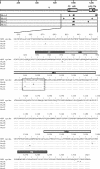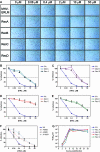Coronavirus escape from heptad repeat 2 (HR2)-derived peptide entry inhibition as a result of mutations in the HR1 domain of the spike fusion protein
- PMID: 18077706
- PMCID: PMC2258948
- DOI: 10.1128/JVI.02287-07
Coronavirus escape from heptad repeat 2 (HR2)-derived peptide entry inhibition as a result of mutations in the HR1 domain of the spike fusion protein
Abstract
Peptides based on heptad repeat (HR) domains of class I viral fusion proteins are considered promising antiviral drugs targeting virus cell entry. We have analyzed the evolution of the mouse hepatitis coronavirus during multiple passaging in the presence of an HR2-based fusion inhibitor. Drug-resistant variants emerged as a result of multiple substitutions in the spike fusion protein, notably within a 19-residue segment of the HR1 region. Strikingly, one mutation, an A1006V substitution, which consistently appeared first in four independently passaged viruses, was the main determinant of the resistance phenotype, suggesting that only limited options exist for escape from the inhibitory effect of the HR2 peptide.
Figures



References
-
- Bosch, B. J., B. E. Martina, R. Van Der Zee, J. Lepault, B. J. Haijema, C. Versluis, A. J. Heck, R. De Groot, A. D. Osterhaus, and P. J. Rottier. 2004. Severe acute respiratory syndrome coronavirus (SARS-CoV) infection inhibition using spike protein heptad repeat-derived peptides. Proc. Natl. Acad. Sci. USA 1018455-8460. - PMC - PubMed
-
- Gallo, S. A., K. Sackett, S. S. Rawat, Y. Shai, and R. Blumenthal. 2004. The stability of the intact envelope glycoproteins is a major determinant of sensitivity of HIV/SIV to peptidic fusion inhibitors. J. Mol. Biol. 3409-14. - PubMed
Publication types
MeSH terms
Substances
LinkOut - more resources
Full Text Sources
Other Literature Sources

